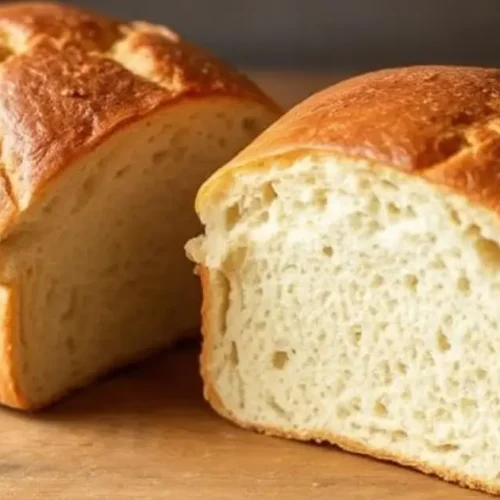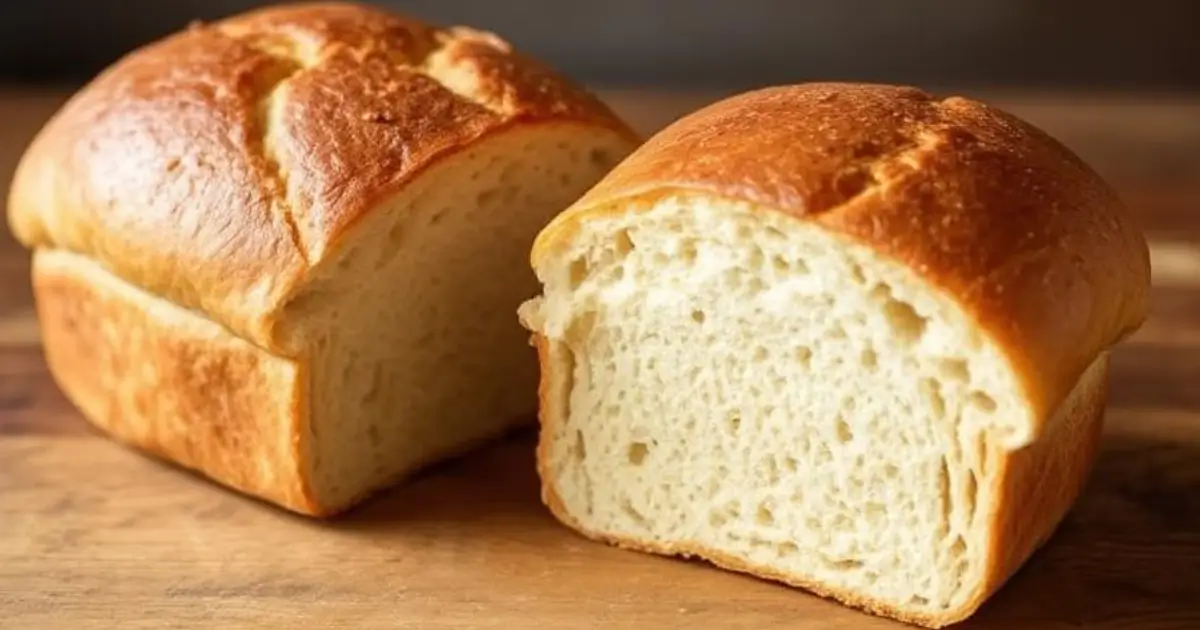Do you have an extra sourdough discard? Turn it into soft, homemade sandwich bread that’s full of flavor and easy to make. This recipe is a great way to use what you have without any waste. It’s perfect for toast, sandwiches, or just enjoying warm from the oven.
Why We Love This
This sourdough discard sandwich bread is one of those recipes that quietly becomes a staple. It’s soft on the inside with a golden, tender crust—perfect for everything from morning toast to stacked sandwiches at lunch. What makes it truly special is how it gives new life to sourdough discard, turning what would be kitchen waste into something warm, wholesome, and worth sharing.
If you’ve ever been intimidated by homemade bread, this one keeps things simple. You don’t need fancy tools or advanced baking skills—just a bowl, some basic pantry staples, and a little time. The sourdough discard adds a gentle tang that makes the flavor stand out without being overpowering, and the texture? Soft and sliceable, just like classic bakery loaves.
We love it because:
- It’s an easy way to use sourdough discard without waste
- The bread has a soft crumb and slices beautifully
- It’s beginner-friendly and forgiving
- It works for both sweet and savory toppings
- It fills your kitchen with that cozy, fresh-baked aroma
Once you make this bread, you’ll see how simple homemade bread can be—and you might never go back to store-bought loaves again.
Ingredients
Making sourdough discard sandwich bread requires just a few basic ingredients, most of which you likely have in your kitchen already. This simple list helps create a beautifully soft loaf with just the right amount of tang from the sourdough discard.
Here’s what you’ll need:
Sourdough discard – This adds tangy flavor and texture to the bread.
Bread flour – Gives the bread its soft, airy texture.
Sugar – Feeds the yeast for a good rise.
Salt – Enhances flavor.
Active dry yeast – Helps the dough rise.
Olive oil – Adds moisture and softness.
Warm water – Activates the yeast for rising.
Instructions
Now that you’ve got your ingredients ready, it’s time to bring everything together and make some sourdough discard sandwich bread! Don’t worry if it’s your first time baking; I’ll guide you through each step to ensure you end up with a beautiful, soft loaf.
Activate the yeast: Mix warm water and sugar in a bowl, then sprinkle the yeast over it. Let it sit for 5-10 minutes until frothy.
Mix the dough: In a large bowl, combine sourdough discard, bread flour, and salt. Add the yeast mixture and olive oil. Stir until the dough starts to come together.
Knead the dough: Place the dough on a floured surface and knead for 8-10 minutes until smooth and slightly tacky. Add more flour if needed.
First rise: Put the dough in an oiled bowl, cover it with a towel, and let it rise for 1-1.5 hours until it doubles in size.
Shape the dough: Punch the dough down, shape it into a loaf, and place it in a greased loaf pan.
Second rise: Cover the dough and let it rise for 30-45 minutes.
Bake: Preheat the oven to 375°F (190°C). Bake the bread for 30-35 minutes until it is golden and hollow when tapped.
Cool: Let the bread cool in the pan for 10 minutes, then transfer it to a wire rack to cool completely before slicing.
Pro Tips
Making sourdough discard sandwich bread is a rewarding experience, and with a few expert tips, you can elevate the process even more. Here are some key insights to ensure your bread turns out perfect every time:
Use room temperature sourdough discard: If your discard is cold, it can slow down the fermentation process. Let it sit out for about an hour before using it in your dough. This ensures a smoother and faster rise.
Don’t skip the yeast activation step: Even though you’re using sourdough discard, adding active dry yeast gives your loaf an extra boost. Always activate the yeast with warm water and sugar to make sure it’s working properly.
Perfect the kneading: When kneading, aim for a smooth and elastic dough. If it feels sticky, add a little flour at a time, but don’t overdo it. Too much flour can make the bread dense. You want the dough to be soft and slightly tacky.
Let the dough rise in a warm place: Yeast loves warmth, so make sure your dough rises in a cozy spot. If your kitchen is cold, try placing the dough near a warm oven or covering it with a blanket to help it rise faster.
Bake to golden perfection: The key to a soft, golden crust is the oven temperature. Preheat your oven well, and if you want a slightly softer crust, you can cover the bread with foil during the last 10 minutes of baking.
Allow the bread to cool completely: I know it’s tempting, but avoid slicing into your bread while it’s still hot. Let it cool on a wire rack so the steam inside can escape, giving you that perfect crumb texture.
Variations
The beauty of sourdough discard sandwich bread lies in its versatility. You can easily customize this recipe to suit your preferences or get creative with different flavor profiles. Here are a few variations to try:
Herb-Infused Bread
Add a tablespoon of dried herbs like rosemary, thyme, or oregano to the dough to infuse your bread with savory flavors. Fresh herbs work, too! Simply chop them finely and mix them in during the kneading step. This is perfect for making sandwiches or serving alongside soups.
Garlic Bread
Want to take your loaf to the next level? Add a few cloves of minced garlic to the dough before the first rise. You’ll end up with a delicious garlic-scented bread that’s perfect for toasting or making into garlic bread.
Cinnamon Swirl Bread
For a slightly sweet variation, roll the dough out before shaping it into a loaf, sprinkle it with cinnamon and sugar, then roll it back up into a swirl. This makes for a cozy, fragrant loaf that’s great for breakfast or as a snack.
Serving Suggestions
Now that your sourdough discard sandwich bread is freshly baked and cooling, let’s talk about how to serve it! This bread is incredibly versatile and pairs beautifully with so many dishes. Whether you’re enjoying it for breakfast, lunch, or dinner, here are some delicious serving ideas:
Classic Sandwiches
The sturdy yet soft texture of sourdough discard bread makes it ideal for sandwiches. Try making a classic turkey and cheese sandwich, or go for a veggie-packed option with hummus, avocado, and fresh greens. You’ll love the balance of flavors between the tangy sourdough and your favorite fillings.
Avocado Toast
If you’re looking for a quick and healthy snack, toast a slice of your sourdough bread and top it with mashed avocado, a sprinkle of salt, and a drizzle of olive oil. For added flavor, add a poached egg or a dash of chili flakes!
More Bread recipes you will love!
FAQs
Can I use sourdough discard straight from the fridge?
Yes, you can! However, it’s best to let your sourdough discard come to room temperature for about an hour before using it in your recipe. This helps it blend better with the rest of the ingredients and ensures a smoother dough. Cold discard can slow down the fermentation process, so warming it up a bit is always a good idea.
How do I know if my sourdough discard is still good to use?
Fresh sourdough discard should have a pleasant, slightly tangy smell. If it smells off, like vinegar or rotten, it’s best to discard it and start fresh. You’ll also notice a layer of hooch (a liquid) on top if the discard has been sitting for a while—this is fine to mix in or pour off based on your preference. If it looks or smells strange, it’s time to toss it.
Can I make this bread without using active dry yeast?
While active dry yeast helps speed up the rise, you can technically make sandwich bread without it. However, it will take longer to rise, and the texture might be slightly denser. If you prefer to rely solely on the wild yeast from the sourdough discard, just allow the dough to ferment for a longer period, either through a slow rise in the fridge or a longer first rise at room temperature.
How long does homemade sourdough bread last?
Homemade sourdough discard sandwich bread will stay fresh for about 3-4 days if stored in a sealed container at room temperature. To extend its shelf life, you can slice and freeze the bread for up to 3 months. Just make sure to wrap it tightly to avoid freezer burn. To thaw, simply let the slices sit at room temperature, or toast them straight from the freezer.
Can I use whole wheat flour in this recipe?
Yes, you can swap part of the bread flour for whole wheat flour for a heartier, nuttier loaf. A 50/50 mix of bread flour and whole wheat flour works wonderfully. Just keep in mind that whole wheat flour absorbs more water, so you might need to add a little extra liquid to get the right dough consistency.

sourdough discard sandwich bread
Ingredients
- 1 cup sourdough discard unfed
- 3 cups bread flour you can substitute with all-purpose flour if needed
- 1 tablespoon sugar this helps feed the yeast
- 1 teaspoon salt for flavor
- 2 teaspoons active dry yeast to give the dough a nice rise
- 1/4 cup olive oil for moisture and a soft crumb
- 1 cup warm water around 110°F/45°C to activate the yeast
Instructions
Activate the yeast
- In a small bowl, combine the warm water and sugar. Stir until the sugar dissolves, then sprinkle the active dry yeast over the surface of the water. Let it sit for 5-10 minutes until it becomes frothy. This step ensures your yeast is alive and kicking.
Mix the dough
- In a large bowl, combine the sourdough discard, bread flour, and salt. Make a well in the center and pour in the activated yeast mixture, along with the olive oil. Stir everything together with a wooden spoon until the dough starts to come together.
Knead the dough
- Turn the dough out onto a lightly floured surface and knead for about 8-10 minutes. If the dough feels too sticky, add a bit more flour, but be careful not to add too much. The goal is to achieve a smooth, slightly tacky dough that’s easy to shape.
First rise
- Place the dough in a lightly oiled bowl, cover it with a clean kitchen towel, and let it rise in a warm place for 1-1.5 hours. You’ll know it’s ready when it has doubled in size. This is the fermentation process, where the dough develops flavor and structure thanks to the sourdough discard.
Shape the dough
- Once the dough has risen, punch it down to release the air. Turn it out onto a floured surface and gently shape it into a loaf. Tuck the edges under to form a smooth top. Place the shaped dough into a greased loaf pan.
Second rise
- Cover the dough again with a towel and let it rise for about 30-45 minutes. This second rise allows the dough to expand and ensures a soft, airy texture in your finished bread.
Bake
- Preheat your oven to 375°F (190°C). Once the dough has finished its second rise, place it in the oven and bake for 30-35 minutes or until the top is golden and the bread sounds hollow when tapped.
Cool
- Remove the bread from the oven and let it cool in the pan for 10 minutes. Then, transfer it to a wire rack to cool completely. This step is important—cutting into hot bread can make it gummy inside.
Send me this recipe!
Just enter your email below and get it sent straight to your inbox!


